To access material, start machines and answer questions login.
This room is intended to further the understanding of basic Linux command line skills for beginners.
Therefore, before doing this room I would highly recommend that you finish the three Learn Linux rooms as it provides all the fundamental teachings that are vital to being able to successfully complete this room.
Furthermore, this room can also serve as useful to intermediate users as it reinforces analytical skills when solving tasks.
If you have read and understood this please begin by clicking the 'completed' button below and 'deploy' the room.
As a security researcher you will often be required to find specific files/folders on a system based on various conditions ranging from, but not limited to the following:
- filename
- size
- user/group
- date modified
- date accessed
- Its keyword contents
Therefore, we can do this using the following syntax:
| What we can do | Syntax | Real example of syntax |
| Find files based on filename | find [directory path] -type f -name [filename] | find /home/Andy -type f -name sales.txt |
| Find Directory based on directory name | find [directory path] -type d -name [filename] | find /home/Andy -type d -name pictures |
| Find files based on size | find [directory path] -type f -size [size] | find /home/Andy -type f -size 10c (c for bytes, k for kilobytes M megabytes G for gigabytes type:'man find' for full information on the options) |
| Find files based on username | find [directory path] -type f -user [username] | find /etc/server -type f -user john |
| Find files based on group name | find [directory path] -type f -group [group name] | find /etc/server -type f -group teamstar |
| Find files modified after a specific date | find [directory path] -type f -newermt '[date and time]' | find / -type f -newermt '6/30/2020 0:00:00' (all dates/times after 6/30/2020 0:00:00 will be considered a condition to look for) |
| Find files based on date modified | find [directory path] -type f -newermt [start date range] ! -newermt [end date range] | find / -type f -newermt 2013-09-12 ! -newermt 2013-09-14 (all dates before 2013-09-12 will be excluded; all dates after 2013-09-14 will be excluded, therefore this only leaves 2013-09-13 as the date to look for.) |
| Find files based on date accessed | find [directory path] -type f -newerat [start date range] ! -newerat [end date range] | find / -type f -newerat 2017-09-12 ! -newerat 2017-09-14 (all dates before 2017-09-12 will be excluded; all dates after 2017-09-14 will be excluded, therefore this only leaves 2017-09-13 as the date to look for.) |
| Find files with a specific keyword | grep -iRl [directory path/keyword] | grep -iRl '/folderA/flag' |
| read the manual for the find command | man find | man find |
Note: There are many more useful commands aside from the examples above. If you ever have trouble understanding any of the syntax or getting it to work, head on over to explainshell.com to check the syntax and see how this tool can help you on your journey to Linux greatness.
Further notes: if you do not know already, typing CTRL+L allows you to clear the screen quicker rather than typing 'clear' all the time. Additionally, hitting the up arrow allows you to return to a previously typed command so you do not have to spend time retyping it again if you made an error. Cool. Finally, placing: 2>/dev/null at the end of your find command can help filter your results to exclude files/directories that you do not have permission to.
What is the correct option for finding files based on group
What is format for finding a file with the user named Francis and with a size of 52 kilobytes in the directory /home/francis/
SSH as topson using his password topson. Go to the /home/topson/chatlogs directory and type the following: grep -iRl 'keyword'. What is the name of the file that you found using this command?
What are the characters subsequent to the word you found?
Read the file named 'ReadMeIfStuck.txt'. What is the Flag?
You should be somewhat familiar already with working with files. Similar to windows, we can do the following:
- copy files and folders
- move files and folders
- rename files and folders
- create files and folders
For a quick recap to train your mental memory on the commands please refer to the below information:
| What we can do | Syntax | Real example of syntax |
| copy file/folder | cp [filename/folder] [directory] (remember, if the filename/folder name has spaces then you will need to encase the filename with speech marks such as cp "[filename with spaces]" [directory]. This applis to other commands such as mv. ) | cp ssh.conf /home/newfolder |
| move file/folder | mv [filename] [directory] | mv ssh.conf /home/newfolder |
| move multiple files/folders simultaneously | mv [file1] [file2] [file3] -t [directory to move to] | mv logs.txt keys.conf script.py -t /home/savedWork |
| Move all files from current directory into another directory | mv * [directory to move files to] | mv * /home/scripts |
| rename files/folder | mv [current filename] [new filename] | mv ssh.conf NewSSH.conf |
| create a file | touch [filename] | touch newFile.txt |
| create a folder | mkdir [foldername] | mkdir newFolder |
| open file for editing | nano [filename] | nano keys.conf |
| output contents of file | cat [filename] | cat keys.conf |
| upload file to a remote machine | scp [filename] [username]@[IP of remote machine ]:/[directory to upload to] | scp example.txt [email protected]:/home/john/ |
| run an bash script program | ./[name of script] | ./timer |
| open a file for reading/editing | nano [filename] | nano readME.txt |
A few additional things to remember is that occasionally you may encounter files/folders with special characters such as - (dash). Just remember that if you try to copy or move these files you will encounter errors because Linux interprets the - as a type of argument, therefore you will have to place -- just before the filename. For example: cp -- -filename.txt /home/folderExample.
Now it is time for your quiz and challenge to see how much you have learned so far.
Hypothetically, you find yourself in a directory with many files and want to move all these files to the directory of /home/francis/logs. What is the correct command to do this?
Hypothetically, you want to transfer a file from your /home/james/Desktop/ with the name script.py to the remote machine (192.168.10.5) directory of /home/john/scripts using the username of john. What would be the full command to do this?
How would you rename a folder named -logs to -newlogs
How would you copy the file named encryption keys to the directory of /home/john/logs
Find a file named readME_hint.txt inside topson's directory and read it. Using the instructions it gives you, get the second flag.
What is hashing?
Next we will talk about hashing, which is important for any Linux security researcher. Hashing refers to taking any data input, such as a password and calculating its hash equivalent. The hash equivalent is a long string which cannot be reversed since the act of hashing is known as a one-way function. For example, if you visit: https://www.md5hashgenerator.com/ and type the following: mypassword123 or any other password, you will see how the hash algorithm known as MD5 will calculate and output a MD5 hash equivalent. Therefore, 'mypassword123' would have the MD5 hash equivalent of '9c87baa223f464954940f859bcf2e233'.

Why is hashing important?
There are several reasons why hashing is
important and I would encourage you to conduct some personal research after this, but the single most
important use case you should concern yourself with in this room is integrity checking.
For example, when you log into a website, your password must be checked with
the local database to verify whether you should be allowed access. But think
critically, if companies stored the username and password in plain text on the
database, it would make it very easy for a successful hacker to be able to compromise
every account. Therefore, it makes more sense to store the hash equivalent instead
of storing the plain text credentials. So, when you send over your username and
password to the database, the system will input these separately into a hash
algorithm and if the output turns out to be equal to the hash equivalent stored
in the database then it will allow you access. Sounds simple, right? If you are
still confused, head over to this video and it should clarify any concerns:
Note: MD5 and SHA1 are both examples of weak hash algorithms which have been proven to be vulnerable to something known as hash collision attacks which is explained further here: https://privacycanada.net/hash-functions/hash-collision-attack/. In short, do not use them because it has been proven that two different inputs can produce the same output (hash equivalent), thus, meaning that your password may produce the same hash as someone with a completely different password. Instead, SHA-256 is widely considered stronger as of today and is recommended.
How to crack hashes?
Hashes can be cracked through the method of brute-forcing. This essentially means using a wordlist and inputting each potential password from the wordlist into the hash function to see if we get a hash equivalent output that is equal to any of the hashes stored in the database. However, in the example we store the hash in a text file before specifying a wordlist to which we want to compare out calculated hashes with.

Using a program called John the Ripper we can specify the format of the hash we wish to crack (md5) the wordlist (rockyou.txt) and the wordlist (hash.txt). Please see the full man page for garnering a more complete understanding of all of the commands you can run with this program.

Eventually John the Ripper may find the password if it was contained the wordlist. In the real world, you may have to find a larger wordlist with a strong amount of common password/username combinations. In this example below the password was found to be 'password'.

Note: If you ever encounter a hash that you do not know the type of you can use a tool called hash-identifier. However, with less widely used hashes the tool will not be accurate and therefore will still rely on you to develop the skill of manually identifying what type of hash it is, however this is out of the scope of this room. The syntax for identifying unknown hashes is as so:
Hash-identifier [hash] as seen below in a real example:

Alternatively you could pipe the output of the file storing the hash to hash-identifier as shown below, which may be quicker.

The result should show us the most likely hash types that the hash most likely is. As you can see there are two most probable hashes. In this case the correct hash was in fact SHA-256, therefore you can see how in most cases the first result is the correct answer, but please be aware that this not always the case since many hash types can appear similar in terms of string formatting.
Note: a more modern and powerful alternative to hash-identifer is a tool called haiti if you're interested:
https://github.com/noraj/haiti
SSH as sarah using: sarah@[MACHINE_IP] and use the password: rainbowtree1230x
What is the hash type stored in the file hashA.txt
What is the hash type stored in the file hashB.txt
Crack hashB.txt using john the ripper, what is the password?
What is base64
Base64 is a group of binary-to-text encoding schemes that represent binary data in an ASCII string format. In summary, it is just another way in which data can be represented; some systems rely on a base64 encoding of data for processing while others may not. Head over to: https://www.base64encode.net/ and input any text and encode it. You should end up with something similar below:
As you can see, the string 'example' gets coverted to the base64 'ZXhhbXBsZQ==' encoded string. This would allow certain systems to now be able to read and process the data properly.

Why should I care?
There may be times when you encounter base64 converted data in files on a system and needed to convert it to a human readable format. Therefore, we can use the tool 'base64' with a pipe to translate it back to something that is human readable.
cat [filename] | base64 -d

to transfer the output to a new text file simply use he > operator followed by the new filename.

Once again, encoding/decoding is changing data format. The data itself does not change, just how it reads.
I encourage you to spend some time reading about encoding. At least enough so you understand the difference between encoding/decoding vs encryption/decryption as beginners sometimes confuse them with each other.
find a file called encoded.txt. What is the special answer?
What is encryption/decryption
Encryption refers to the process of concealing sensitive data by converting it to an unintelligible format. The only way to reverse the process is to use a key; this is known as decryption. For further explanation please visit:https://www.cisco.com/c/en/us/products/security/encryption-explained.html but in short, encryption is just a way to protect data using a private key. For example, the following string 'secret data' can be converted to 'QFnvZbCSffGzrauFXx9icxsN9UHHuU+sCL0sGcUCPGKyRquc9ldAfFIpVI+m8mc/' using a key derived from the password 'pass'. It is also important to note that there are many different types of encryption schemes, known as algorithms such as AES-256/128, 3DES, Blowfish, etc. Among these, AES is considered to be the recommended encryption algorithm to use due to the fact that it has been tested and proven to be a strong scheme. Furthermore, there are two main types of encryption methods, asymmetric and symmetric. However, in this room we will be focusing on symmetric encryption. If you are interested in knowing the difference or more on encryption please visit: https://www.thesslstore.com/blog/types-of-encryption-encryption-algorithms-how-to-choose-the-right-one/
How to encrypt
As seen below, we have a text file with sensitive information inside of it.

This can be encrypted using the the program gpg to encrypt it using the AES-256 scheme:
gpg --cipher-algo [encryption type] [encryption method] [file to encrypt]

You will notice how it will ask for a password. This is when you can specify a password for gpg to derive the key from.
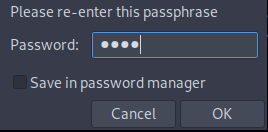
Then a new encrypted file will be created with the extension gpg as you can see below.

If you attempt to read the contents of this file you will see how it shows unintelligible code.

How to decrypt
Decrypting is very easy as it only takes one line as shown below:
gpg [encrypted file]

Note: You may notice how it does not ask us for the password to decrypt the file, this is because we we have already entered it when we were encrypting the file and so Linux stored the password for quick use. However if we restart our system or attempt to decrypt the file in a different linux machine, it will ask us for the password to decrypt the file.
Remember: You can always use the man pages to learn more about what you can do with gpg.
Find an encrypted file called layer4.txt, its password is bob. Use this to locate the flag. What is the flag?
How to crack encrypted files using john the ripper
Now that you have a basic understanding using gpg, the next question is, what if we do not have the password or key to decrypt the file? How can we crack this. Well, similar to how we brute-forced the hashes in task 4 with John the Ripper, we can do the same for encrypted files.
If you are using Kali linux or Parrot OS, you should have a binary add on called gpg2john. This binary program allows us to convert the gpg file into a hash string that john the ripper can understand when it comes to brute-forcing the password against a wordlist. Simply type 'sudo gpg2john' into your terminal to ensure you have it. The output should be as seen below. In any case if you do not have it installed head over to: https://github.com/openwall/john and follow the instructions to install it.

Next, type the following command below to generate the hash for John the Ripper:
gpg2john [encrypted gpg file] > [filename of the hash you want to create]

The command above allows us to generate the hash for John the Ripper to understand. Next we can begin the fun part of cracking the encrypted file as seen below:
john wordlist=[location/name of wordlist] --format=gpg [name of hash we just created]

The result should reveal the password if you have used a strong wordlist that contains it.

What is SQL?
SQL is a language for storing, manipulating and retrieving data from databases. Therefore, it is important to firmly grasp the concept of how to read data from databases in Linux. If your understanding of databases is weak or you understanding nothing about them, please read this first before continuing: https://www.elated.com/mysql-for-absolute-beginners/ as it will explain fully the concept of databases for beginners. The key thing to remember is that developers mostly create 'relational databases' which use multiple databases that reference each other for organising data, hence the name 'relational databases'. Furthermore, each database contains tables of records and each table can consist of multiple columns and rows which store the data in a organised format. Now that we have gotten that out of the way let's begin.
Since this is a beginners room we will be reading the database of a local mysql workspace. This can be done as follows:
Service mysql start/stop
Start starts mysql while stop stops it. Additionally, you could use restart if you encounter any issues while mysql is running.

Connect to remote SQL database:
Mysql databases can be hosted for remote access. To access remote databases use the following command:
mysql -u [username] -p -h [host ip]

Open SQL database file locally:
To open mysql file/files locally, simply change to the directory of the mysql file and type mysql as shown below. You'll be taken to a specialised command prompt for mysql.
Note: In some cases you may have to run mysql -p [password] if the mysql system was configured to require authenticiation.
1. mysql -u [username] -p

Type "source" followed by the filename of the mysql database to specify that you wish to view its database.
2. source [sql filename]

Displaying the databases
After this, you will see how mysql takes a little time to load the database. Once finished, type the following too see all of the relational databases:
SHOW DATABASES;
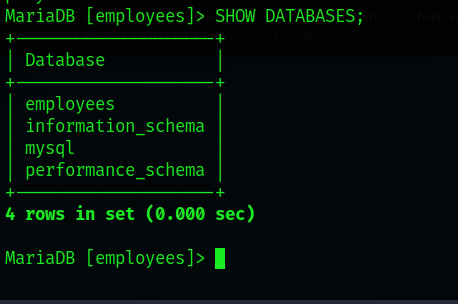
Choosing a database to view
We can select one of the databases by using the use command followed by the name of it. In the example below we select the 'employees' database.
USE [database name]

Displaying the tables in the selected database
We can display which tables inside that database we selected previously using:
SHOW TABLES;
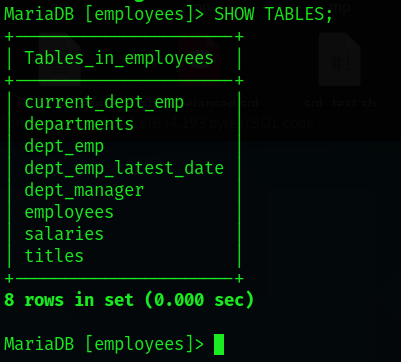
Describing the table data structure
We can also view the table structure of individual tables using the DESCRIBE command:
DESCRIBE [table name]
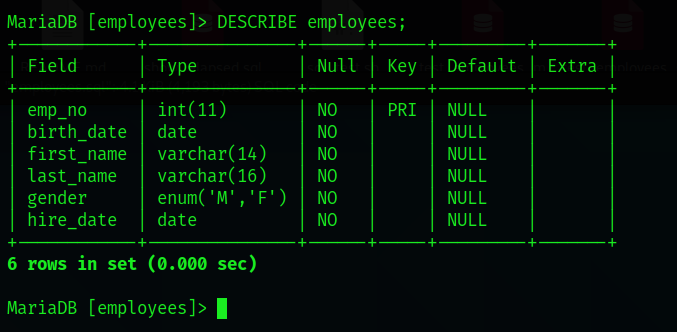
Displaying all the data stored in a specific table
Now for the really fun part. Let's display all the data stored in the employees database using the following:
SELECT * FROM [table name]

As seen below, we can see that this database contains some personal employee information.
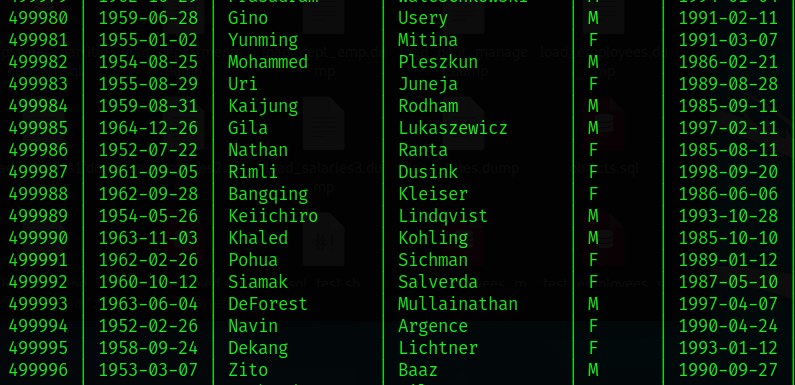
Go to the /home/shared/chatlogs directory and read the first chat log named: LpnQ. Use this to help you to proceed to the next task.
What is Sameer's SSH password?
What is the password for the sql database back-up copy
SSH as james and change the user to root?
What is the root flag?
Ready to learn Cyber Security? Create your free account today!
TryHackMe provides free online cyber security training to secure jobs & upskill through a fun, interactive learning environment.
Already have an account? Log in
